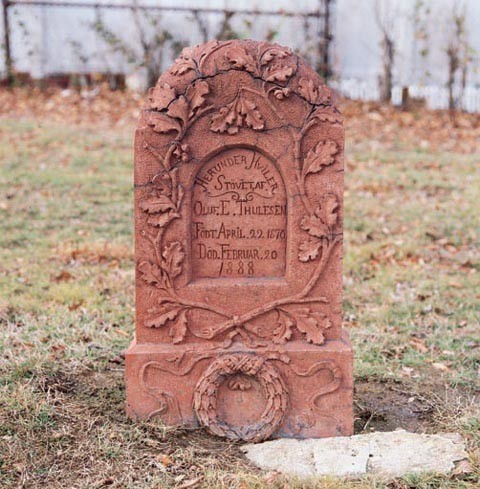
Gravemarker, Perth Amboy, New Jersey, 1888. Terracotta. H. 34 1/2". (Photographs by Gavin Ashworth unless otherwise noted. ) The Oluf Thulesen marker is made from a single piece of unglazed red terracotta. It is decorated with carefully sculpted oak boughs, complete with acorns. The marker is located in Alpine Cemetery, Perth Amboy.

Detail of the oak boughs on the gravemarker illustrated in figure 1. The tree of life cut down was a common Victorian gravemarker design. This snapped twig conveys the same idea, a life cut short. Oluf Thulesen was only eighteen when he died.
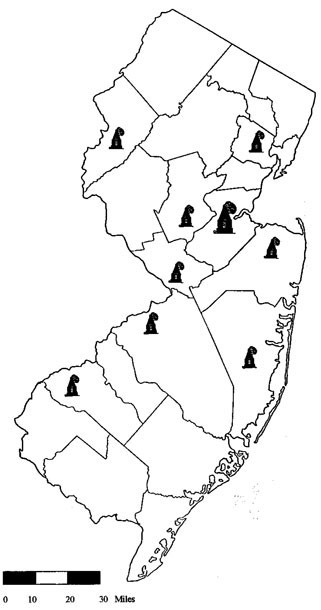
The kilns on this map show the approximate location of New Jersey’s major terracotta manufacturers. (Courtesy, IA: The Journal of the Society for Industrial Archaeology.) The Raritan Formation of Cretaceous clays runs transversely across New Jersey from northeast to southwest.
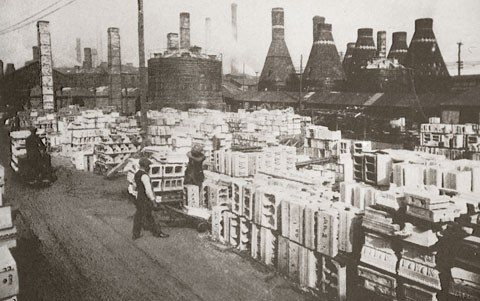
Photograph of the Atlantic Terracotta Company’s Perth Amboy factory. (Collection of Richard Veit.) This early-twentieth-century photograph gives a good idea of the size of typical pieces of architectural terracotta. Note that almost all of the blocks are hollow.
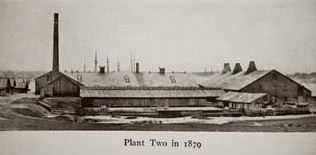
Photograph of the Perth Amboy Terracotta Company. (Courtesy, Collection of the Historical Society of Princeton.) This photograph shows Alfred Hall’s original brickworks/yellow ware pottery turned terracotta factory on Buckingham Avenue in Perth Amboy as it appeared in 1879.
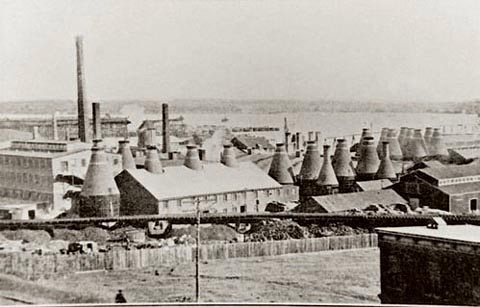
Photograph of the Perth Amboy Terracotta Company’s factory from Geological Survey of New Jersey, Vol. IV, Clay Industry, 1904. Notice the enormous kilns.

Postcard photograph of the South Amboy Terracotta Company, later part of the Federal Seaboard Terracotta Corporation. (Collection of Richard Veit.) Note the line of kilns and the extensive stock of finished ware
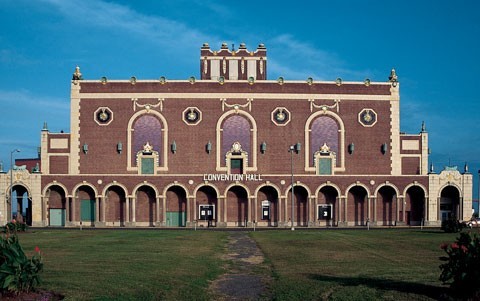
Asbury Park Convention Hall, 1928–1930, New Jersey. (Photo, Richard Veit.) The building features buff and polychrome terracotta details. The terracotta employed in it was produced by the Federal Seaboard Terracotta Corporation.
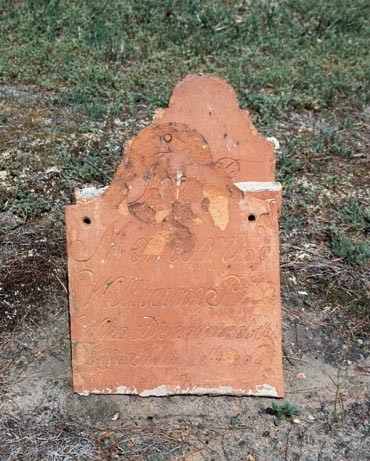
Gravemarker, Mount Holly, New Jersey, 1804. Terracotta. H. 18". (Photo, Richard Veit.) This early ceramic gravemarker marks the final resting place of William Price. Presumably it was produced by a local potter. Apparently it broke in two and was repaired, unsuccessfully, with some sort of adhesive. An accompanying footstone also survives.
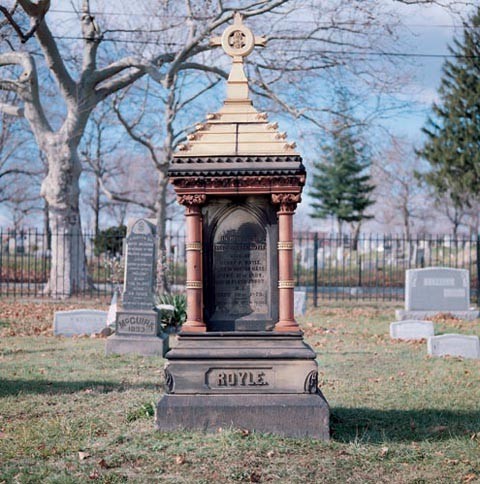
Gravemarker, Perth Amboy, New Jersey, 1879. Terracotta and sandstone. H. 120". The Ellen Falvey Royle gravemarker is located in St. Mary’s Cemetery, Perth Amboy. It dates from 1879 and employs both buff and red terracotta. The core of the marker, which has survived less well than the terracotta, is sandstone. The roof and cross are yellow, unglazed terracotta; the columns are red, unglazed terracotta.
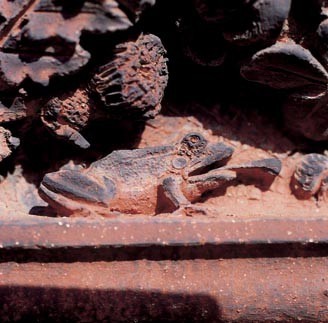
Detail of the frieze on the south side of the gravemarker illustrated in fig. 10. The frieze depicts a menagerie of small animals, including flies, spiders, frogs, and birds. One wonders whether they were intended for the gravemarker or reused from some other project. The frog seen here is about to swallow a spider. The frog is approximately two inches tall.

Gravemarker, Perth Amboy, New Jersey, ca. 1870. Terracotta and marble. H. 88". The Sofield family memorial, located in Alpine Cemetery, is one of the larger surviving terracotta monuments. When erected it was ornamented with four marble plaques inscribed with personal information about the deceased. Only two of these remain: one for David Sofield, age 76, and another for his wife, Mary, age 70. David died in 1873, his wife in 1870. Either the marker is backdated or it was erected after other family members passed on, as there were no terracotta producers in Perth Amboy in 1870.

Gravemarker, Perth Amboy, New Jersey, 1878. Terracotta. H. 57". The C. Madsen marker, made from buff-colored unglazed terracotta, is located in Alpine Cemetery. Made for a six-month-old child, it shows amazing attention to detail.
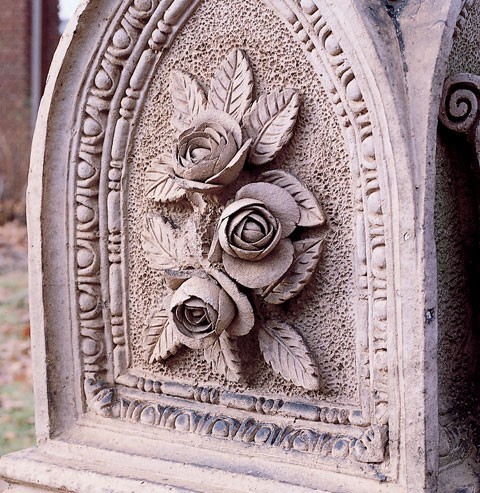
Detail of the gravemarker illustrated in fig. 13. One of four clusters of roses applied to the faces of the Madsen marker. Note the similarities between the stippled background on this marker and that of the Thulesen marker (see fig. 1). Although neither piece is signed, one wonders if the same craftsman produced them.
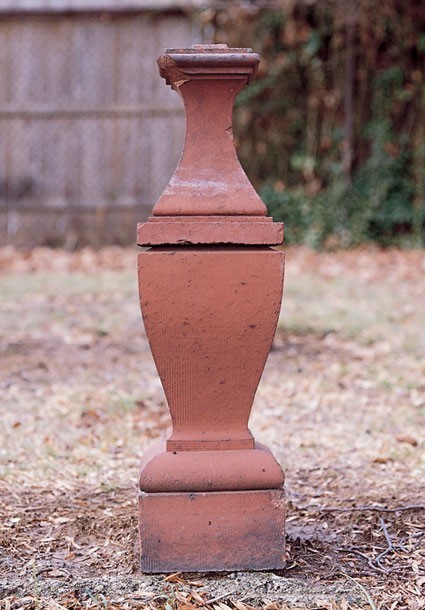
Gravemarker, Perth Amboy, New Jersey, ca. 1880. Terracotta. H. 32". This uninscribed baluster, molded from red, unglazed terracotta, is a good example of the architectural pieces that were employed as gravemarkers. It is located in Alpine Cemetery.
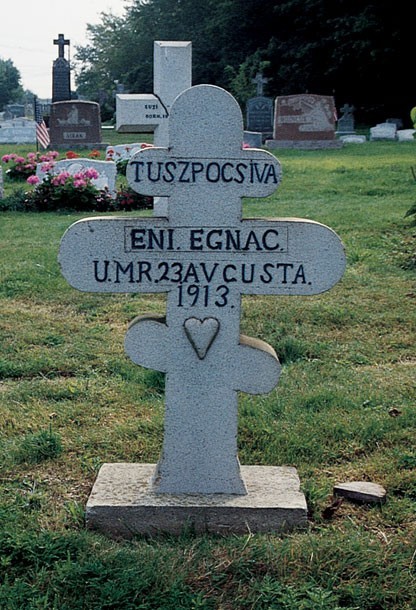
Gravemarker, Woodbridge, New Jersey, 1913. Terracotta. H. 29". The Eni Egnac marker is located in St. John the Baptist Greek Catholic Cemetery. This three-bar cross marker is made from white glazed terracotta.
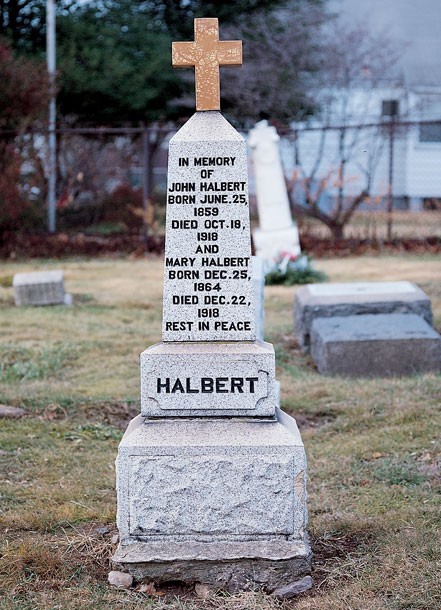
Gravemarker, Perth Amboy, New Jersey, 1918. Terracotta. H. 75". The John and Mary Halbert marker is a good example of mass-produced terracotta gravemarkers with faux granite finish. The granite-like texture was produced using a sprayed on glaze and was marketed under the trade name Granitex. The marker dates from 1918 and is located in Alpine Cemetery.
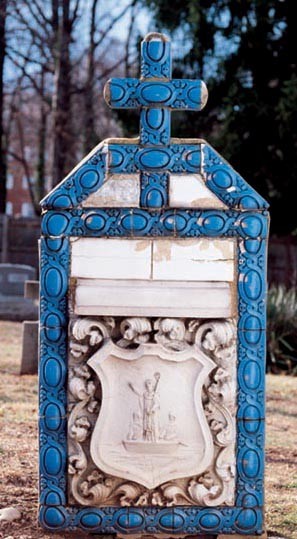
Gravemarker, Metuchen, New Jersey, ca. 1920. Terracotta. H. 70". This is an uninscribed polychrome gravemarker from Hillside Cemetery. It incorporates deep blue tiles for the border and cross around a centerpiece shield that shows St. Christopher. These pieces may have been scavenged from other projects. Together they form a remarkable composition.

Gravemarker, Perth Amboy, New Jersey, 1900. Terracotta. H. 27". The Joseph Bauman marker is made of brick red terracotta and combines a cross motif with a golden Star of David. It is located in St. Mary’s Cemetery, and dates from 1900. This is the back of the marker.
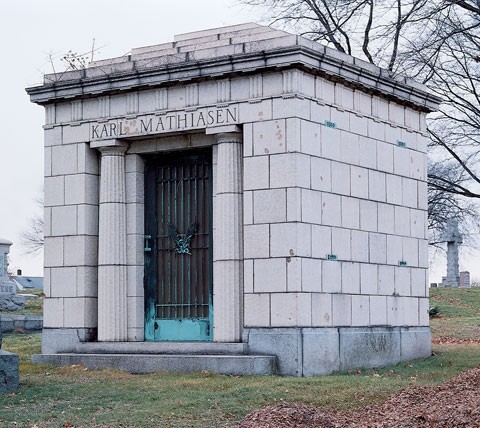
Mausoleum, Perth Amboy, New Jersey, 1920. Terracotta. H. approx. 144". Karl Mathiasen was a motivating force behind the development of New Jersey’s terracotta industry. A Danish immigrant, he worked as a potter for Alfred Hall after coming to America. Later, he worked for terracotta manufacturer Robert Taylor in Boston, and subsequently at the Perth Amboy Terracotta Company. In 1888 he and his brother-in-law Otto Hansen founded their own firm. In 1893 it became the New Jersey Terracotta Company, later part of Federal Seaboard. His mausoleum, which appears to be made from granite is, of course, terracotta.
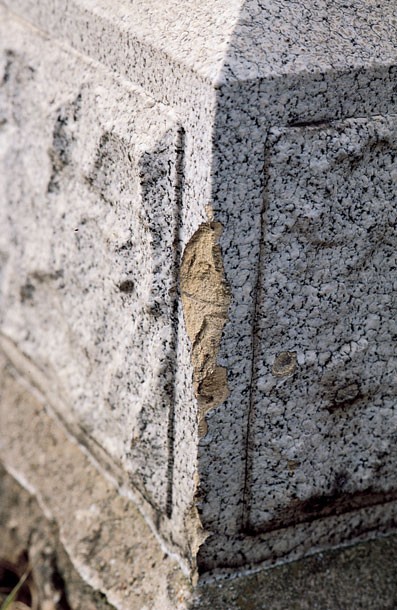
Detail of the gravemarker illustrated in fig. 17. This close up of the Halbert marker shows the terracotta body underneath the granite-like glaze.
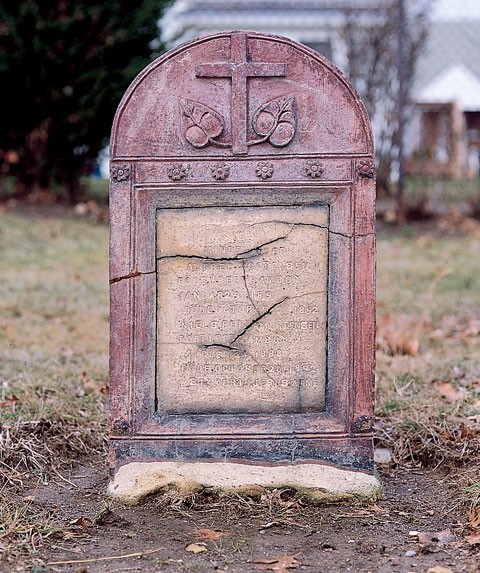
Gravemarker, Perth Amboy, New Jersey, 1892. Terracotta. H. 29". This pastel colored terracotta gravemarker commemorates two children: Alfred Mortensen (1891–1892) and Niels Peter Mortensen (1888–1892). The inscription is in Danish. The gravemarker is located in Alpine Cemetery.

Gravemarker, Metuchen, New Jersey, 1905. Terracotta. H. 80". The Bruno Grandelis marker is arguably the most artistic terracotta monument produced. It is also the only marker that depicts an actual individual. The monument is located in Hillside Cemetery
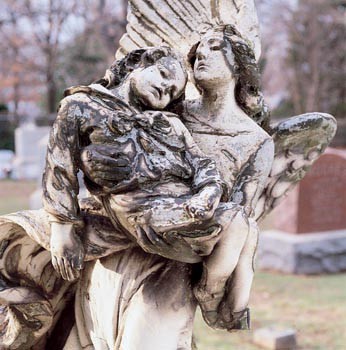
Detail of the gravemarker illustrated in fig. 23.

Reverse of the gravemarker illustrated in fig. 23.

Fraternal marker, Perth Amboy, New Jersey, ca. 1900. Terracotta. H. 14". These mass-produced ceramic gravemarkers were erected by members of the Danish Brotherhood and Sisterhood, a fraternal organization begun by Danish-American Civil War veterans. The gravemaker is located, as are many just like it, in Alpine Cemetery.
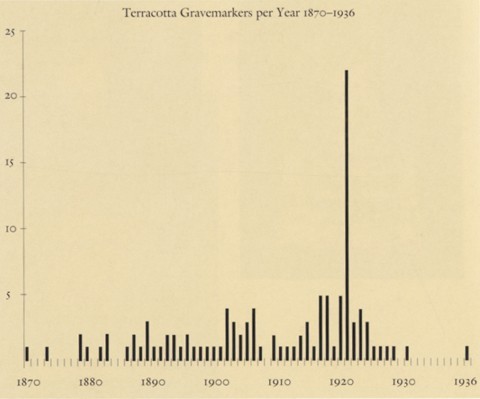
A bar chart showing dated terracotta gravemarkers and the years in which they were erected. (Courtesy, Richard Veit.) Notice the strong peak in 1918 that coincides with the influenza epidemic brought home by troops returning from World War I.
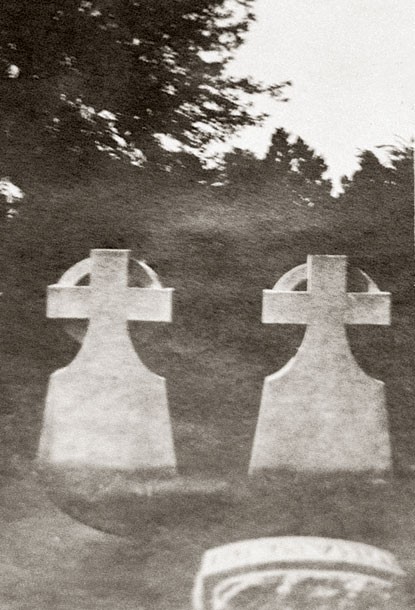
A photograph showing plaster models of proposed terracotta gravemarkers. (Courtesy, Columbia University, Avery Architectural and Fine Arts Library, Columbia University in the City of New York and the Friends of Terracotta Collection.) These were made by the New York Architectural Terracotta Company, working at the request of a Mr. Henry Hiss, from Woodlawn Cemetery, New York, and date from 1915. It is not clear that the New York company pursued the idea any further, though markers had long been made informally by many firms.
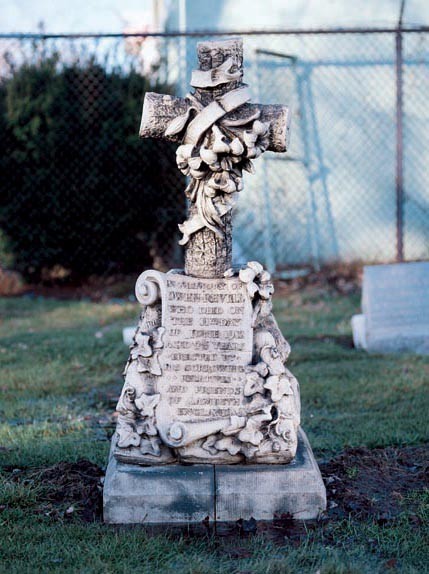
Gravemarker, Perth Amboy, New Jersey, 1912. Terracotta. H. 50". The Owen Revell marker is located in Alpine Cemetery. Made from unglazed tan terracotta, it is inscribed “Erected by his sorrowing relatives and friends of Lambeth England.” Lambeth was a center of ceramic manufacture, and one might speculate that Revell had learned his trade there.

Wall plaque, Perth Amboy, New Jersey, ca. 1928. Terracotta. H. approx. 36". A miniature polychrome Statue of Liberty adorns the façade of the former Greek Catholic Carpatho-Rusin Benevolent Association on Broad Street. It shows, on a small scale, the skill of the clayworkers. Note the interesting juxtaposition of the American flag, the three-bar cross, and the socket for an electric bulb in Liberty’s hand.
